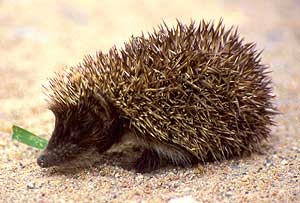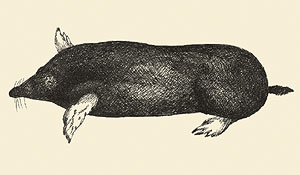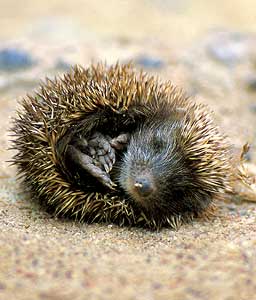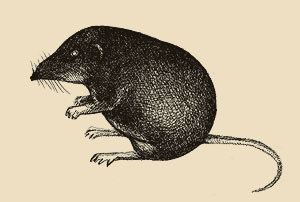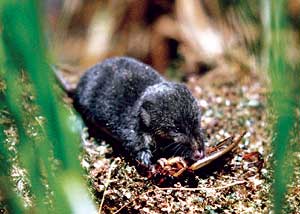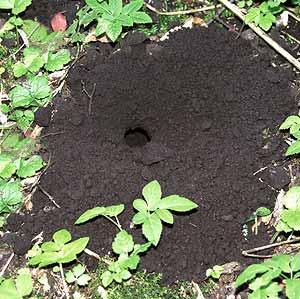|
MAMMALS
|
||||||||||||||
Text:
|
Insectivores Insectivora
These are small mammals, the oldest and most primitive group of placental mammals. Insectivores represent the oldest, initial group from which more specialized orders evolved. This hypothesis is supported by a number of primitive features of these animals. For example, their skull is elongated as it was in their ancestors. Insectivores’ teeth are only slightly differentiated. Apart from hedgehogs all European species have a muscular snout. Their cerebral hemispheres are so small that they do not entirely cover the brain and they do not even have convolutions. The testes in most insectivore species are permanently hidden in the abdomen.
The life of insectivores, similarly to insects, their prey, depends strongly on the type of vegetation, soil structure, and, in aquatic species, on the type of water. Three representatives of insectivores live in Poland: hedgehogs (Erinaceidae), shrews (Soricidae), and moles (Talpidae).
The hedgehog (Erinaceus europaeus) is a relatively common species living on the boundaries of forests, parks and gardens. It can be seen mainly at night and twilight; the young are also active in daylight. During the day it hides in thick shrubs, under piles of stones or in brush-wood. It is a solitary animal. The hedgehog feeds on insects and earthworms, but also eats young rodents, amphibians and reptiles. When endangered it rolls itself into a ball, protecting itself with protruding spines. Contractions of the strong muscular layer enable the skin to be tensed, moving the spins to erect. The head and legs are hidden under the muscular cover, and the whole animal forms a hispid ball being well protected against the attacking enemy. However, the spiny coat does not provide protection against parasites such as ticks, lice and itch mites.
Hedgehogs hibernate. In spring, they start rutting soon after waking up. During copulation the female lays its spines as flat as possible. The young are born completely blind and naked. The spines develop quickly: they are hidden in the skin and are very soft at first. The young, sporting a bright patch on their dark-brown chests, are reared exclusively by the mother. At the age of 3 weeks they begin to venture out, and when they are 6 weeks old they start living on their own. Unfortunately, people very often take young hedgehogs home, as imagine they have been abandoned. Many well-meant attempts to save hedgehogs by taking them indoors during the winter for wintering are fatal to them. In the natural environment hedgehogs live for between 8 and 10 years.
The common shrew (Sorex araneus) is the most widespread representative of the shrew family. It lives mainly in deciduous and mixed forests, but it can be quite often in gardens, fields, in the baulks, in highlands and lowlands, near human settlements or even inside them, but always near water. The common shrew digs tunnels in loose soil. The tunnels are connected by corridors used by the animal shrews in the search for foods. Similarly to other shrews it is a voracious eater. It feeds on insects, spiders, snails, caterpillars and carrion. The common shrew often attacks animal prey bigger than itself. A specific feature of this species is its fast metabolism and short life-span: shrews live only 12-15 months. They are active all the day and night. The young are born in a nest lined with a soft layer of moss and leaves. At the time of birth they weigh ca 1 g. Their naked skin is so thin that internal organs can be seen easily. Common shrews are very fertile. A female delivers 2-4 litters of 5-9 young per year. It is considered to be very useful species for agricultural and forest management.
The water shrew (Neomys fodiens) is the largest representative of the Polish native shrews. It occurs in lowland water, in rivers and mountain streams, with clean running water and a clean stony or sandy bottom. It is well adapted to living in the aquatic environment. The rear digits are covered with silver bristles, facilitating swimming, while the tail serves as a rudder. It is a very good diver. The water shrew browses with its snout in the mud and underneath stones on the bottom in a search for small animals. It captures the larvae of insects, small fish, tadpoles, small frogs and snails in aquatic environment. It also hunts on land. It is active both day and night. The water shrew lives in burrows dug in soft soil in the immediate neighbourhood of water or under tree roots. However, tunnels made by moles or rodents are its favourite shelter. The entrances, located on the steep banks of water reservoirs, have specific appearance: there is a small platform, quite often lined with grass. The water shrews deliver 2-3 litters per year, with 4-8 young by one litter. The six-weeks young already live on their own. The young that are born in early spring can reproduce in the same spring as they are sexually mature 4 months after the birth.
The European mole (Talpa europaea) is one of the mammals well adapted to living below ground. It prefers living in meadows, fields, in gardens, on forest boundaries: sometimes it dwells in wetlands, but it avoids sandy areas. The mole digs an extended system of underground galleries and burrows, removing excavated soil to the surface where it forms the so-called molehills. It can dig underground thanks to its well-adapted forelimbs. The limbs are very wide and strong, and their digits end in long claws. Each underground burrow system consists of two different parts: living and hunting sections. The residential part has a ”bed” stuffed with very soft leaves and moss. The hunting galleries are used by the mole as roads and traps for the prey. In autumn the mole often protects itself against severe frosts by digging another, even deeper chamber. It also deepens other chambers: larders for storing forage. The mole has a very specific method of storing earthworms: it damages their nervous system, and brings the paralysed but living earthworms to its larder. Apart from earthworms, the mole feeds on beetles and their larvae, amphibians, reptiles and small rodents.
|
|||||||||||||
|
|
|
